#American Basin
Explore tagged Tumblr posts
Text
San Juan Soda Co. : Lake City
Giclée Archive Poster Prints
Fine Art Paper Prints: 12X16=$130 • 16X20=$155 • 18X24=$195 • 24X36=$280 • 30X40=$545 • 40X60=$820
Canvas Gallery Wraps (standard depth 1.5 inches ready to hang): 16X20=$475 • 18X24=-$670 • 24X36=$770FREE SHIPPING in 5-7 Business Days!!
#art#poster#gift#colorado#lake city colorado#Lake Fork of the Gunnison#Lake Fork#Hinsdale County#Wildflowers#American Basin#wildflower landscape#Colorado posters#San Juan Soda Co.#Downtown Lake City#Historic Buildings#Colorado Historic Buildings#Ice Cream Shop in Lake City Colorado#Lake City Colorado art#Poster Print#Vintage Artwork#Vintage Colorado Art#Flower Baskets#Mountain flowers#Lake City Colorado Summer#Lake City Originals#Lake City Colorado Poster Prints
0 notes
Text
#Congo#people of congo#congo mines#congo rainforest#congo basin#free congo#congo genocide#congolese#democratic republic of the congo#dr congo#save congo#help congo#important#please boost#signal boost#news#american news
491 notes
·
View notes
Note
Have you done the hoatzin yet? My all time favorite bird 💕
Not yet! Good choice! For those who don't know, these unique birds mostly eat leaves (rare in birds!) and their young have primitive claws. They have been the subject of a lot of scientific attention!
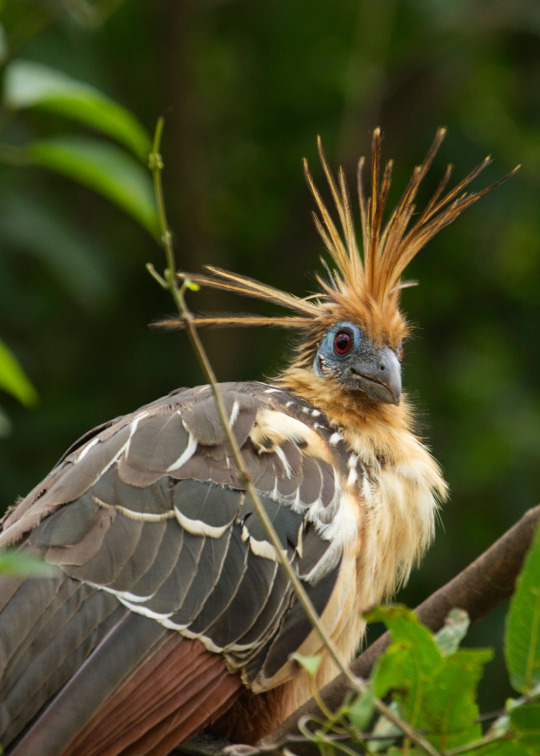
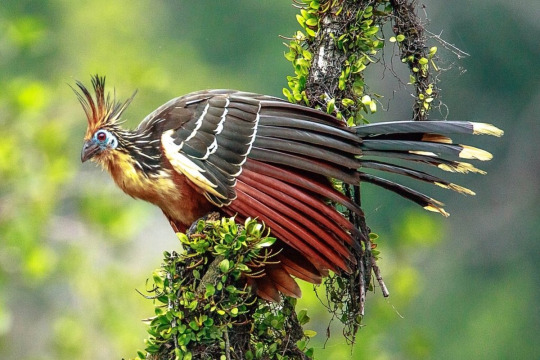
#south american bird#south american birds#hoatzin#Canje pheasant#amazon rainforest#orinoco basin#bird#birds#ornithology#animal polls#poll blog#my polls#animals#polls#tumblr polls
128 notes
·
View notes
Text

Desert Views...
75 notes
·
View notes
Text

lifetimes stretching forever
Calico Basin, Nevada
#indie#film photography#filmisnotdead#ghosts in love#original photography#photographers on tumblr#southwest#zach bradley#emotive#las vegas nevada#calico basin#landscape photography#american southwest#desert ghosts#nikon n55#mojave desert#outdoors#35mm
48 notes
·
View notes
Text

Springdale, Utah outside Zion National Park
#National parks#Zion canyon#utah#road trip#photography#American southwest#Mojave desert#Great Basin#Colorado plateau
15 notes
·
View notes
Text

Anaconda, Queen of the Amazon.
#vintage illustration#snakes#anaconda#the amazon#south america#jungles#south american jungle#amazon basin#amazon river#eunectes murinus#herpetology#biology#zoology
29 notes
·
View notes
Text










Grimes Point Archaeological Area, Fallon NV (No. 5)
Keep an eye out for all kinds of shapes, including swirls, desert bighorn sheep, and distinctive peck marks forming smooth divots—a signature petroglyph at Grimes Point. Keen-eyed visitors will note that, running east and west along the ridge behind the site, lays evidence of an aboriginal drift fence for driving deer or antelope. After all, the act of creating a petroglyph was often a ritual performed by a group leader before each hunt. These petroglyphs can be seen on boulders within a short walking distance of the rest area, but if you’re up for more of an active interpretation, jump in the car and head just one mile up the road.
This Nevada Bureau of Land Management (BLM) site has recently employed new restrooms, five sheltered picnic tables, an informational kiosk, benches, and a paved parking lot and road. In addition to the interpretive trail, a guided education program is provided for those interested in learning more about Great Basin history.
Source
#Grimes Point Archaeological Area#Fallon#Churchill County#Nevada#travel#original photography#vacation#tourist attraction#landmark#landscape#archaeology#US history#Native American#free admission#USA#summer 2024#countryside#nature#flora#Desatoya Mountains#Clan Alpine Mountains#Pit and Groove Petroglyph#petroglyph#Great Basin Pecked#Grimes Point Petroglyph Trail#Pleistocene Lake Lahontan#lichen
2 notes
·
View notes
Video
A Nevada Highway Leading Me to a Mountain Destination by Mark Stevens Via Flickr: While on Loneliest Road in America (US 50) with a view looking into Nevada and some distant ridges and peaks of the Snake Range in Great Basin National Park. My thought on composing this image was to get down low and capture a look across the highway. I picked a point a little ways down in order to have more of the far away portions in focus. The rest of the image composition was merely lining up the highway and center stripe and exposing the image to capture the brighter portions caught in sunlight behind the mountains.
#Along Roadside#American West#Asphalt Road#Azimuth 273#Bald Mountain#Blue Skies#Blue Skies with Clouds#Border Inn#Cave Mountain#Center Stripe#Day 7#Desert Landscape#Desert Mountain Landscape#Desert Overlook#Desert Plant Life#DxO PhotoLab 5 Edited#East Central Great Basin Ranges#Great Basin National Park#Great Basin Ranges#High Desert#Intermountain West#Landscape#Landscape - Scenery#Loneliest Road in America#Looking West#Mountain Peak#Mountains#Mountains in Distance#Mountains off in Distance#Mountainside
5 notes
·
View notes
Text
Who Were The Tarim Basin Mummies? Even Scientists Were Surprised. The Enigmatic, Extremely Well-preserved Mummies Still Defy Explanation—and Draw Controversy.
— By Erin Blakemore | September 15, 2023

Hundreds of bodies have been excavated from cemeteries like this one around the Tarim Basin in Xinjiang, a region of Western China. Known as the Tarim Basin mummies, these people lived some 4,000 years ago—and their ancient DNA has yielded surprising insights. Photograph By Wenying LI, XinJiang Institute of Cultural Relics And Archaeology
Though they died thousands of years ago, hundreds of bodies excavated in East Asia’s Tarim Basin look remarkably alive. They retain the hairstyles, clothing, and accoutrements of a long-past culture—one that once seemed to suggest they were migrant Indo-Europeans who settled in what is now China thousands of years ago.
But the mummies’ seemingly perfect state of preservation wasn’t their only surprise. When modern DNA research revealed the preserved bodies were people indigenous to the Tarim Basin—yet genetically distinct from other nearby populations—the Tarim Basin mummies became even more enigmatic. Today, researchers still ask questions about their cultural practices, their daily lives, and their role in the spread of modern humanity across the globe.
How Were The Tarim Basin Mummies Found?
Buried in a variety of cemeteries around the basin as long as 4,000 years ago, the naturally mummified corpses were first unearthed by European explorers in the early 20th century. Over time, more and more of the Tarim bodies were unearthed, along with their spectacular cultural relics. To date, hundreds have been found. The earliest of the mummies are about 2,100 years old, while more recent mummies have been dated to about 500 B.C.

One of the most famous mummies found in the Tarim Basin is the Princess of Xiaohe, also known as the Beauty of Xiaohe. Named for the cemetery where her body was found, she is remarkably well-preserved even down to her eyelashes. Photograph By Wenying LI, XinJiang Institute of Cultural Relics And Archaeology
Who Really Were The Tarim Basin Mummies?
At first, the mummies’ Western-like attire and European-like appearance prompted hypotheses that they were the remains of an Indo-European group of migrant people with roots in Europe, perhaps related to Bronze-Age herders from Siberia or farmers in what is now Iran.
They had blond, brown, and red hair, large noses, and wore bright, sometimes elaborate clothing fashioned from wool, furs, or cowhide. Some wore pointed, witch-like hats and some of the clothing was made of felted or woven cloth, suggesting ties to Western European culture.
Still others wore plaid reminiscent of the Celts—perhaps most notably one of the mummies known as Chärchän Man, who stood over six feet tall, had red hair and a full beard, and was buried over a thousand years ago in a tartan skirt.
Another of the most famous of the bodies is that of the so-called “Princess” or “Beauty” of Xiaohe, a 3,800-year-old woman with light hair, high cheekbones, and long, still-preserved eyelashes who seems to be smiling in death. Though she wore a large felt hat and fine clothing and even jewelry in death, it is unclear what position she may have occupied in her society.
But the 2021 study of 13 of the mummies’ ancient DNA led to the current consensus that they belonged to an isolated group that lived throughout the now desert-like region during the Bronze Age, adopting their neighbors’ farming practices but remaining distinct in culture and genetics.
Scientists concluded that the mummies were descendants of Ancient North Eurasians, a relatively small group of ancient hunter-gatherers who migrated to Central Asia from West Asia and who have genetic links to modern Europeans and Native Americans.
How Were They Mummified?
These bodies were not mummified intentionally as part of any burial ritual. Rather, the dry, salty environment of the Tarim Basin—which contains the Taklimakan Desert, one of the world’s largest—allowed the bodies to decay slowly, and sometimes minimally. The extreme winter cold of the area is also thought to have helped along their preservation.
How Were They Buried?
Many bodies were interred in “boat-shaped wooden coffins covered with cattle hides and marked by timber poles or oars,” according to researchers. The discovery of the herb ephedra in the burial sites suggests it had either a medical or religious significance—but what that religion might have been, or why some burials involve concentric rings of wooden stakes, is still unclear.

Mummified corpses were first unearthed in the Tarim Basin by European explorers in the early 20th century. Their Western-like appearance and clothing originally led researchers to believe these ancient people were migrants from Europe—but DNA later debunked that theory. Photograph By Wenying LI, XinJiang Institute of Cultural Relics And Archaeology
What Did They Eat?
Masks, twigs, possibly phallic objects, and animal bones found at the mummies’ cemeteries provide a tantalizing view of their daily lives and rituals. Though most questions about their culture remain unanswered, the burials did point to their diets and the fact that they were farmers. The mummies were interred with barley, millet, and wheat, even necklaces featuring the oldest cheese ever found. This indicates that they not only farmed, but raised ruminant animals.
What Were Their Daily Lives Like?
The Tarim Basin dwellers were genetically distinct. But their practices, from burial to cheesemaking, and their clothing, which reflects techniques and artistry practiced in far-off places at the time, seem to show they mixed with, and learned from, other cultures, adopting their practices over time and incorporating them into a distinct civilization.
Researchers now believe their daily lives involved everything from farming ruminant animals to metalworking and basketmaking—helped along by the fact that the now-desolate desert of the Tarim Basin region was once much greener and had abundant freshwater.
Researchers also believe that the Tarim Basin residents traded and interacted with other people in what would eventually become a critical corridor on the Silk Road, linking East and West in the arid desert.
But archaeologists still have much to learn about what daily life was like for these ancient humans, including who they traded with, what religious beliefs they adopted, and whether their society was socially stratified.

Most of the bodies were found buried in boat-shaped coffins like this one, with the site typically marked by oars. This coffin is covered with a cattle hide, suggesting that the Tarim Basin people raised cattle and other ruminant animals. Photograph By Wenying LI, XinJiang Institute of Cultural Relics And Archaeology
Why Are The Tarim Basin Mummies Controversial?
The amazingly preserved mummies have long fascinated archaeologists. But the Tarim Basin mummies have also become political flashpoints. The Tarim Basin is located in the modern-day Xinjiang Uyghur Autonomous Region, land claimed by China’s Uyghur minority. Uyghur nationalists claim the mummies are their forbears, but the Chinese government refutes this and has been reluctant to allow scientists to study the mummies or look at their ancient DNA.
In 2011, China withdrew a group of the mummies from a traveling exhibition, claiming they were too fragile to transport. Some research about the mummies’ DNA has been criticized as downplaying the region’s distinctness in support of China’s attempts to assimilate Uyghur people. Just as more remains to be learned about the enigmatic mummies, their future as political and national symbols remains disputed too.
#History & Culture#Tarim Basin | Mummies#Scientists#Enigmatic | Extremely Well-Preserved Mummies | Defy Explanation#Draw Controversy#Xinjiang | China 🇨🇳#East Asia’s Tarim Basin#Western China 🇨🇳#Buried | 4000-Year-Old#Naturally Mummified Corpses | 20th Century | European Explorers#Mummies | Western-Like Attire | European-Like Appearance#Bronze-Age Herders | Siberia Russia 🇷🇺 | Farners in Iran 🇮🇷#Western European Culture#Celts#Chärchän Man#Princess | Beauty | Xiaohe#Central Asia | West Asia#Modern Europeans | Native Americans#Boat-Shaped Wooden Coffins | Covered | Cattle Hides | Marked | Timber Poles or Oars#Barley | Millet | Wheat 🌾 | Necklaces | Oldest Cheese 🧀#Silk Road | Linked | East and West | Arid Desert ���#Tarim Basin | Modern-Day Xinjiang | Uyghur Autonomous Region
16 notes
·
View notes
Text
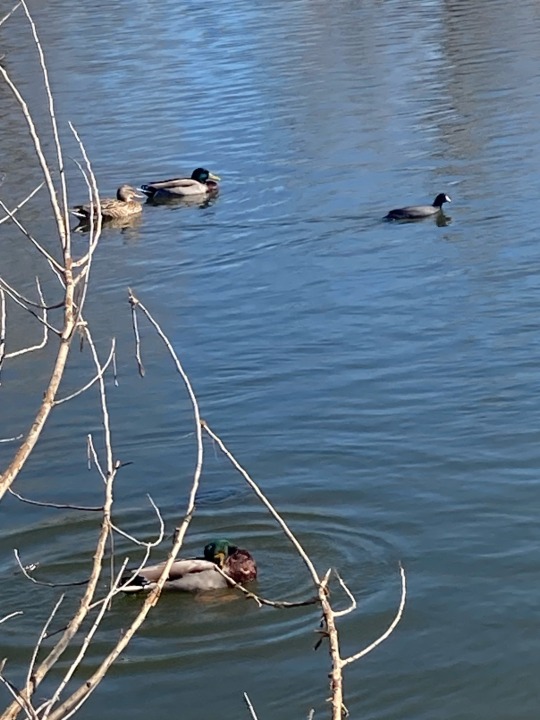
#bird video#nature video#mallards#ducks#anas platyrhynchos#american coot#fulica americana#waterfowl#birds#wildlife#lake#sepulveda basin wildlife reserve#van nuys#video
6 notes
·
View notes
Text
#Congo#people of congo#congo mines#congo rainforest#congo basin#free congo#congolese#democratic republic of the congo#help congo#congo genocide#dr congo#save congo#important#please boost#signal boost#news#american news
16 notes
·
View notes
Text
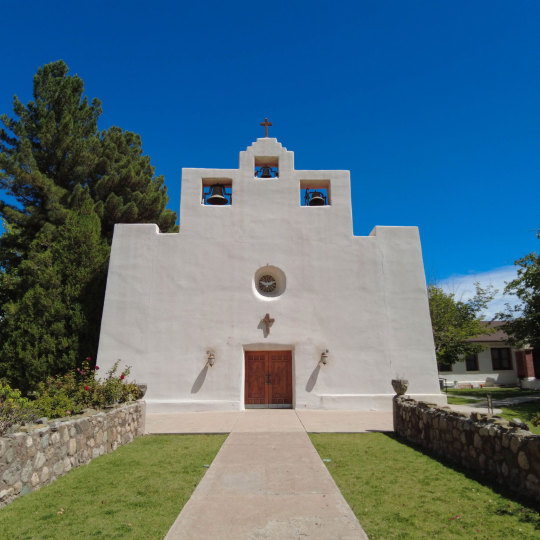
The settlers of Tularosa started building St. Francis de Paula church in 1868. Villagers built the church with over 50,000 adobe bricks. The original design was based on the Spanish colonial influence brought from Mesilla. The current church is not the original structure. It is about twice as big as the original.
2 notes
·
View notes
Note
Might I inquire as to what, precisely, a Mustain't is? (Aside from a string of letters I hesitate to Google in that order.)
In October 2014 I went on a road-trip to the Driest Place In America.
I was having a rough year, very depressed from having dropped out of college for the third time. I decided a road trip was in order to re-set my brain and get a little distance. Being that it was October, and therefore all the campgrounds in the American Southwest were filled with people who have the good sense to camp in reasonable temperatures, I elected to take my parent's minivan so I could car-camp anywhere suitably isolated, and looked up some of the southwest's geographic extremes- the highest place I could drive to (Pikes Peak), the lowest place (Badwater Basin), and for fun, the Dryest Place in the continental US, which turned out to be the Pinacate Volcanic field just west of Organ Pipe Cactus National Monument. It gets rain maybe twice a century and has no standing water, despite being less than 100 miles from the gulf of California.
It's a startlingly beautiful and alien place. The ground is a deep chocolate brown to black volcanic sand, and in mid October, the rabbit brush is turning bright yellow as it shifts to autumn, the organ pipe cacti are a dark green and stand, partially concealed in the brush at exactly human height. The air is alive with birds and insects and bats at night. The stargazing is like looking into the eyes of God.
You get there by driving down a little dirt road called "El Camino Del Diablo", or "The Devil's Road".
I drove out about three hours from Glendale, AZ to get there, arriving at sunset, and felt a profound sense of peace. I stargazed, listening to the bats hunt and sing, and slept peacefully for the first time in months.
I stayed out there for three days, sketching and painting the landscape, taking strolls through this almost alien landscape, and enjoying the light and sound and total absence of human intrusion besides myself.
On the fourth night, it was a new moon, and I awoke in the middle of the night. Something was amiss, and it took me a while to realize it was because I could NOT hear the bats. I was sleeping inside the van with the rear windows rolled halfway down rather than trying to set up the tent, so I when I sat up, I looked out of the van's reflective windows to discover what at first appeared to be A Horse.
It was something between pale gray and bright white in the starlight, standing maybe a dozen feet from the van, sniffing curiously. It made sense- I was in the middle of mustang country and there was quite a bit of foliage in the area for it and it did look like a truly wild horse- lumpy where the bones were jutting out, dusty about the hooves and face.
I was instantly seized by the sort of paralytic fear Sleep paralysis is made of. I couldn't move. It wasn't quite looking at me because it couldn't quite see through the windshield into the shadowy into the shadowy interior, but I had the distinct impression that if I looked away, it would know, and get me.
I already had problems with horses. My beloved Aunt Helen's Prize mare tried to kill me on two separate occasions, and the year before I had to carry my sister-in-law backwards out of a slot canyon whilst reciting the Saint Crispin's Day Speech as loudly as possible to keep a mustang from trampling us to death.
This is approximately what it should have looked like:
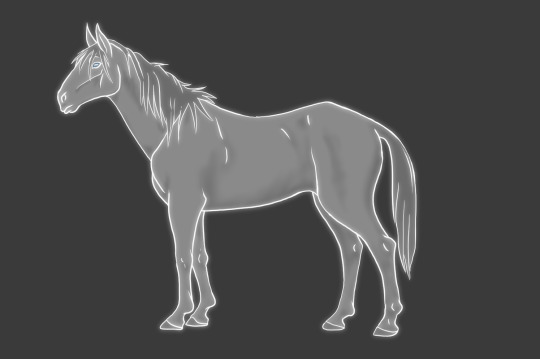
Instead, it was... off. like trying to draw a horse from memory.
The waist tapered in.
The legs were slightly too long or the torso slightly too short, probably both.
The ears were Triangular.
The head wasn't quite right- Too narrow and the jaw wasn't heavy enough.
The tail was too long and arced unnaturally away from the body.
The neck arched.
The nostrils were too high and close
The mouth too long.
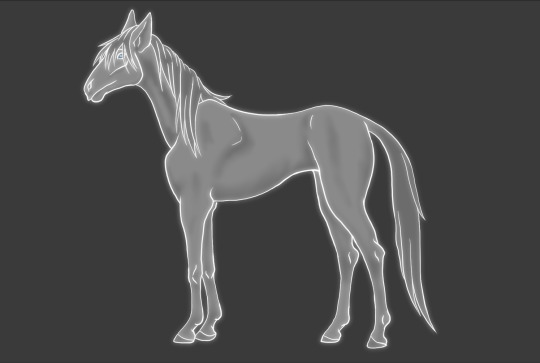
Whatever this is, a Mustang it Ain't.
I watched it from the back seat as it sniffed around the front of the van, curious with about the side mirrors. It moved around the van, nibbling experimentally on the front door handle. It came up to the side windows, sniffing like a dog, and it's breath didn't fog up the glass.
Finally, it came up to the rear window, which was rolled halfway down to let the fall night air in. Not even half a pane of glass and two feet of air between us, and I could clearly see it's bright blue eyes.
Horses have Elongated pupils to give them a wide field of vision, and eyes that rotate sideways in their sockets so the pupil remains parallel to the ground. Rather creepy to watch, especially the ones with blue eyes.
A real horse that was curious about the interior of the van would have come up to the window more or less sideways, and looked at me with something like this:
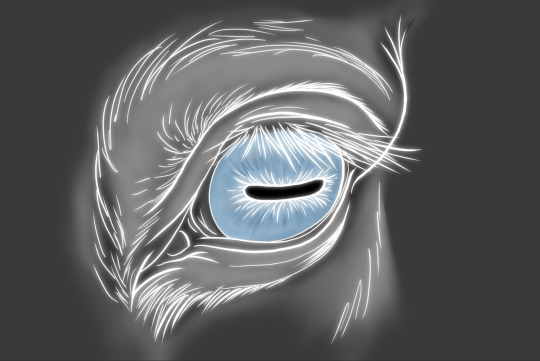
Instead, the damn thing walked up and faced the back window head on, staring back at me with this:
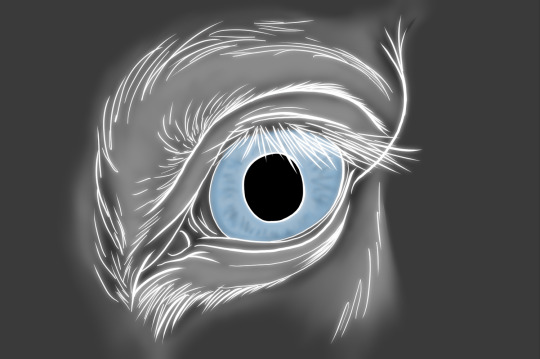
I'm not sure how long we watched each other like that, eyes locked. My eyes burned. I couldn't blink. My mouth was dry. I couldn't swallow. My throat began to ache. I couldn't make a sound. My skin began to twitch, like I was severely dehydrated. I couldn't move. My lungs burned. I couldn't move. I couldn't move. I couldn't move. I couldn't move.
Something was touching the side of my hand on the seat next to me. It's my water bottle.
The realization must have broken the terrible paralysis in the lower parts of my brain first, because by the time I consciously realized I could move again, I was already flinging my water bottle out the window at it.
The top was open, and splashed out the window at the Mustain't.
I've never heard such a scream out of an animal. Something halfway between the sound of unquenchable rage vibrating in someone's chest and the way rabbits cry out to God when the dogs catch them.
It jumped back, pivoting away from the van, snarling at the water bottle. I don't think you're supposed to be able to see All of a horse's teeth at once, no matter how angry it is.
I watched it run into the night for some distance, it's pale body visible against the black sand and the dark gray shadow of the ancient volcanic cone it was headed for.
When the blood stopped pounding in my ears, I could hear the bats again.
I debated leaving right then, but I didn't want to get out of the van with that thing in the area, nor litter by leaving the water bottle out there. I also had the awful idea that if I left now, it might somehow be able to follow me home. I ended up staying up three hours to watch the sunrise, shaking and trying to figure out if I'd woken up from a vivid dream, if my meds had stopped working, or if that had really happened. I didn't dare move until I actually felt the temperature rise, before stepping out of the van to grab the bottle. I had my camera ready- I was still using a DSLR back then- to take pictures of the hoofprints, to show how close it had gotten to the van.
No hoofprints.
Beetle tracks in the soft sand around the van, and the clear foot-and-wing prints of a bird that had hopped around then taken off. But no hoofprints.
I went over the entire campsite with the tent broom, to make sure I removed every scrap of evidence I had ever been there, including my footprints, grabbed my water bottle, and drove the three hours back back to Glendale, then decided to do seven more hours of driving to Moab, Utah just to put more than 500 miles, the state line and at least nine things that could be considered "running water" between me and the Mustain't.
-
I still have that water bottle. It has a dent in the bottom from hitting something, but that could have happened at any time. Strange thing though. I can't drink that bottle dry. I'll have it on me, drink whatever I've put in there- water, juice, iced coffee- and eventually feel like I've drunk the whole think and that it's empty. But I open it up and it's still at least a quarter full. I drink that. I get thirsty. I open it up again. ...and there's always a mouthful left.
Not sure what the side effects of drinking from a bottle cursed by a Mustain't to always have some left are, but it lives in the Emergency Breakdown Kit in my car now, just in case I meet another one.
---
(I'm a disabled artist and make my living telling stories, please consider supporting me on Ko-Fi or Pre-order the Family Lore book on Patreon)
#Family Lore#scary stories to tell in the dark#or out camping#Horses#sort of#The Mustain't#long post#trypophobia#I know these are usually funny but this one is spooky
12K notes
·
View notes
Text
It’s Native American Heritage Month

Photo by Tailyr Irvine
(11/24/2023) In addition to learning and celebrating the history of indigenous peoples, we must support indigenous peoples and communities that are alive today and have been alive for centuries.
I currently live on the lands of the Wyandot, Mississauga, Potawatomi, and Anishinabek people. These people lived here for thousands of years before white settlers colonized the land in the 1800s. I will always support indigenous liberation and sovereignty.
To my non-native US and Canadian followers -- if you’re new to the Land Back Movement, you can start by learning whose land you’re on here. Land acknowledgment is the first step, and from there you can reach out to your neighboring First Nation to start building relationships and learn how you can support them. There are still SO many non-native folks in the U.S. who don’t know the history of American colonialism and acts of state-sanctioned genocide committed against Native Americans -- acts that are still ongoing to this day. I know this is kinda poli sci 101 and this has been said already, but we need to continue educating ourselves and each other. Education is one of our greatest tools in the fight against colonialism and imperialism. Knowing that, I'm sharing some current issues that are threatening indigenous people and communities. These are not exclusively indigenous issues either -- they are issues that concern humanity as a whole.
It is also important we build our communities around things that are positive such as art, literature, and culture. So to bolster these things, I'm also sharing some indigenous content creators, authors, and shops. Thank you to @help-ivebeen-turned-into-aparrot for the recommendations and expanding this list!
Remember history, celebrate Native American heritage, and stay informed! Links below the cut.
Current Major Issues (as of November 2023)
Navajo Nation Water Rights Overview (NARF) Resources and how to help (from 2020, still valuable)
Alaskan Ambler Road Overview (Winter Wildlands Alliance) Paving Tundra, a short documentary Take action
Nevada Lithium Mine Overview (First Nations) People of Red Mountain/how to help
Missing And Murdered Indigenous Women Info and overview (Native Hope) Mission

Native American History and Culture
The books and articles with links are freely available. To read the others, you might be able to find them at a nearby library using WorldCat.
Introduction to Native American History by Native Hope
Stories, Dreams, and Ceremonies: Anishinaabe ways of learning by Leanne Simpson
Origin and Traditional History of the Wyandotts by Peter D. Clarke
Handbook of North American Indians, Volume 11: Great Basin by William C. Sturtevant and Warren L. D'Azevedo
Shoshonean Peoples and the Overland Trails by Dale L. Morgan
Diné History of Navajoland by Klara Kelley and Harris Francis

Native American-Owned Shops
Thunder Voice Hat Co. - handmade hats, hat accessories, and other apparel. Kotah Bear - blankets, robes, and jewelry. Owned by two people of Navajo Nation, selling art and jewelry made by Navajo and Pueblo artists. Manitobah - moccasins, mukluks, and other winterwear. A global brand founded by Sean McCormick, a Métis entrepreneur. Also has the Indigenous Market, which sells handmade products by indigenous artists from Canada and the US. Little Inuk Beadwork - jewelry and accessories. Made by Lillian Putulik, Inuk artist. Mobilize - streetwear and fashion. Founded by Dusty LeGrande, Nehiyaw artist and activist. Based in Edmonton, CA.

Authors
Moniquill Blackgoose - science fiction and fantasy. Seaconke Wampanoag author. To Shape A Dragon's Breath Angeline Boulley - young adult thriller fiction. Chippewa author. Firekeeper's Daughter Cherie Dimaline - Métis author, mostly YA fiction. The Marrow Thieves, Hunting by Stars, Funeral Songs for Dying Girls Darcie Little Badger - science fiction and fantasy. Lipan Apache author. Elatsoe, A Snake Falls to Earth Stephen Graham Jones - horror fiction. Blackfoot Native American author. The Only Good Indians, Mongrels, After the People Lights Have Gone Off Delphine Red Shirt - autobiographies, culture, oral tradition. Oglala Lakota author. Turtle Lung Woman's Granddaughter, Bead on an Anthill: A Lakota Childhood, George Sword's Warrior Narratives Dani Trujillo - romance. Chicana/Pueblo author. Lizards Hold the Sun

Content Creators
Che Jim - humor, skits, social and political issues. Diné/Nishnaabe/Chicano content creator. Lillian Putulik - art and jewelry. Nunavik Inuk artist. Bossii Masu Nagaruk - current events and social and political issues. Iñupiaq content creator. David Little Elk - educating about and celebrating Oglala Lakota tribal wisdom. Oglala content creator. Edgar Martin del Campo - educating about cultures, languages, and religions of indigenous peoples of North and South America. Casey (aka Hot Glue Burns on insta) - cosplay and cosplay design/creation.
#native american heritage month#important#I follow all these content creators and some were recommended by my friend L#by no means a comprehensive list and I encourage everyone to go follow more indigenous folks if you aren’t already#tried to include very broad history as well as more specific history#I focused on groups from the great basin and around the great lakes only because that happens to be my wheelhouse#thank you again L I love you!
0 notes
Text










Grimes Point Archaeological Area, Fallon NV (No. 3)
It’s one thing to read about the artwork created by Nevada’s indigenous peoples, but it’s an entirely different experience to see these prehistoric masterpieces in person, especially when they’ve blended with nature. That’s exactly what you’ll find at Grimes Point Archaeological Area along the Loneliest Road in America, minutes east of Fallon, Nevada.
About seven miles east of Fallon along the Loneliest Road in America, a short interpretive trail weaves among a rocky canvas etched with prehistoric petroglyphs. About 1.5 miles beyond lies Hidden Cave, a four-millennia-old Paiute-Shoshone storage site, which can be toured with guides from the Churchill County Museum.
Source
#Grimes Point Archaeological Area#Fallon#Churchill County#Nevada#travel#original photography#vacation#tourist attraction#landmark#landscape#archaeology#US history#Native American#free admission#USA#summer 2024#countryside#nature#flora#Desatoya Mountains#Clan Alpine Mountains#Pit and Groove Petroglyph#petroglyph#Great Basin Pecked#Grimes Point Petroglyph Trail#Pleistocene Lake Lahontan#lichen
4 notes
·
View notes